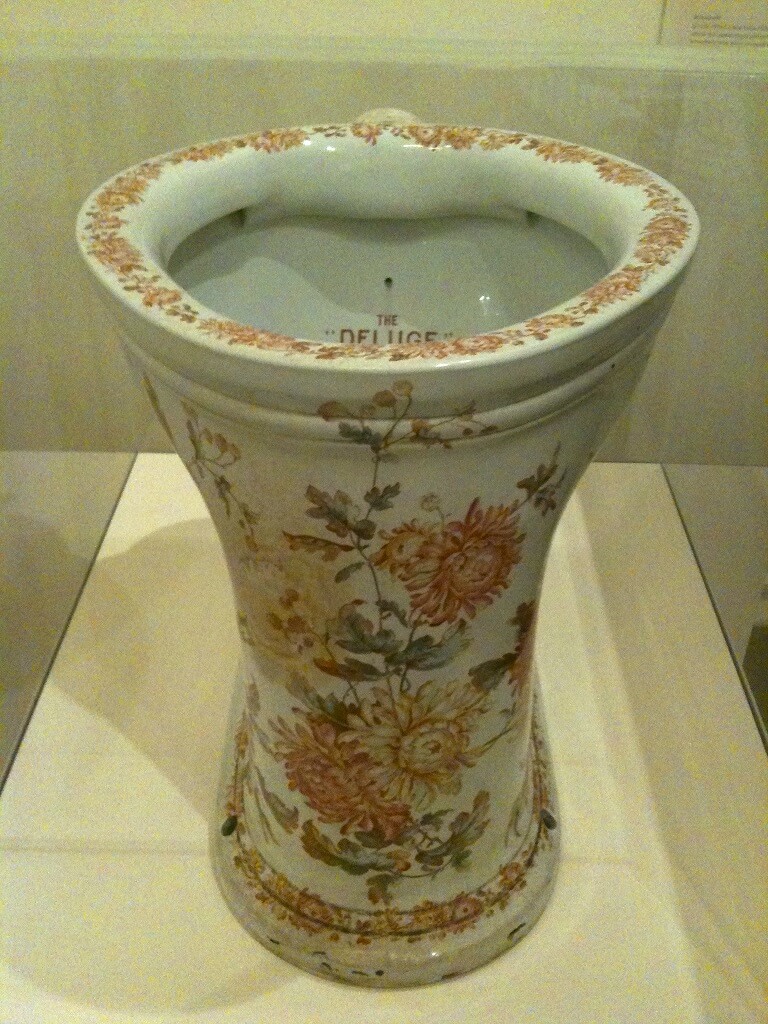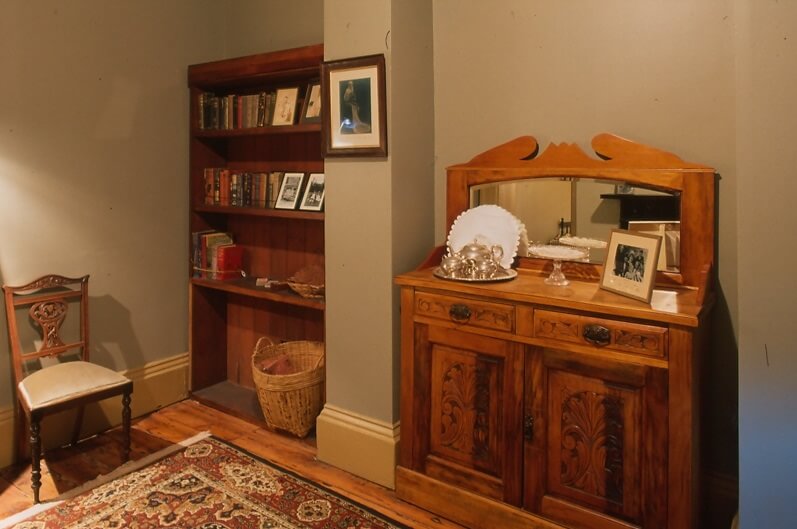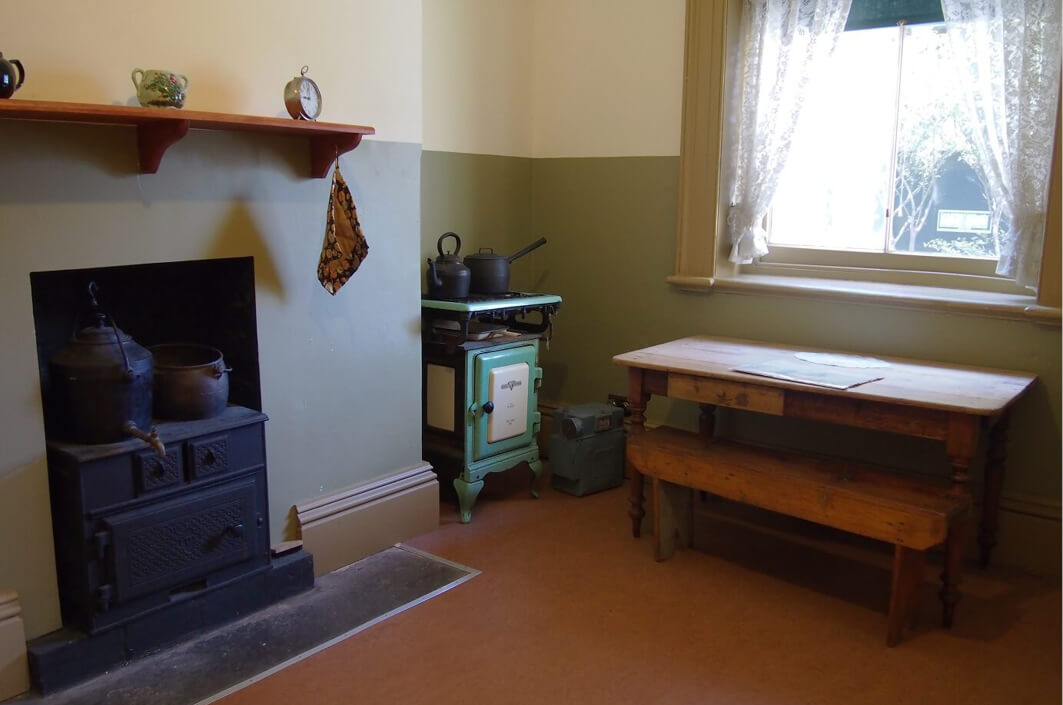Daily Chores
With a family of eight children, there were many chores to be done – and usually in the scullery. The boys brought in buckets of hot water from the outside washhouse for the deep bath, the girls washed dishes in an enamel basin, and everyone took turns to top up the hot water fountain on the wood fired stove. Food was also prepared here – loganberry jam, preserved fruit, and fresh milk was set for clotted cream and butter. There were no labour saving devices then. Tedious daily work was interspersed with fun and family life.
Once or twice a week Mr Maynard harnessed the horse to a jinker and drove to Victoria Market. He bought cases of fruit which he displayed for sale on a fruit barrow in the passage in the basement of the Old Treasury Building near the lift-well.
The Rooms
Old Treasury was a cold place in which to live, but the dining room’s warm fire made life a little more comfortable. Mrs Maynard spent many hours in this room, making and mending clothes for the family on the treadle sewing-machine. From here she could look out into the courtyard towards the stables, bungalows and washhouse — and watch her children play. Her life here was hard and often lonely, with few neighbours.
Several lady friends used to visit on occasions in the evenings. One would play the piano and the other would sing. Mrs Maynard’s favourite song was ‘Mighty like a Rose’.
The Kitchen
The kitchen was the centre of activity. Here, bread was baked and family meals cooked and eaten — pigeon pie was a favourite. Mealtimes in the kitchen were when the family could all get together. Sitting around the large wooden table, everyone would share the stories of their day — playing in the vaults, creeping upstairs to the Governor’s office, riding the wire-cage lift, games of cricket, trips to the market, and being driven to school in a government car.
When the children were little they ran through the buildings. Their father would get upset, especially when they got onto the roof, which was covered with lead.
At night it was very quiet. Everything closed at 11 o’clock. Sundays were very quiet too.
Heating and Cooling
Old Treasury was a very cold place to live, and so the wood fuelled stove always burned, heating the oven for baking and the hot water fountain for washing. Mother was meticulous in her cleaning. She scalded cups with hot water before use, for fear of common yet serious diseases – diphtheria, scarlet fever, tuberculosis and influenza. The 1920’s saw the introduction of gas and electric stoves. Eventually, they replaced the cast iron wood fuelled stoves. The cast iron stoves were difficult to use. Fires had to be set, lit and maintained using wood, coal or coke. Cleaning the stove was an even harder job, requiring determination and strong wrists. Firstly, the ash had to be removed. Then the stove was scrubbed with lemon juice on balls of newspaper and emery cloths. The job was finished with a coat of black lead moistened with household ammonia or vinegar.
Kitchen Juggernauts
In the 1920s the cast-iron juggernauts such as the LUX Patent Cooking Stove still dominated the kitchen they were now in competition with the newly arrived gas and electric cookers. These wood stoves came with a built in plate warmer, fluebrush lifter, raker, baking tin and firebox. Keeping a wood-stove clean was a monumental task involving daily vigilance, lemon juice, old newspaper, emery clothes, black lead, ammonia and lots of elbow grease.
Food
Mealtimes were in the kitchen, with the family crowded around a wooden table. This was a time to share stories from the day – playing in the old gold vaults, creeping upstairs to the Governor’s office, or the early morning trips with Father to the Victoria Markets on the horse and jinker.
READ MORE
Food Storage and the Coolgardie Safe
With no refrigeration, the Maynards kept perishable food in the Coolgardie Safe. This was a simple cupboard made of wire mesh and pressed metal. A wet hessian bag hung over the side would keep the cupboard and its food cool.
Kitchen safes, small cupboards with wire mesh sides and doors, date from the nineteenth century. They continued to be part of the basic kitchen furniture through the 1920s before the development of built-in cupboards and refrigerators.
The Coolgardie Safe was designed to store meat and other foods, which required from protection from the heat of the Australian summer.
Storing perishable food was a constant problem in the days before refrigeration. The first home refrigerators arrived in 1927. Until this time food was either kept cool with ice and Coolgardie Safes, or preserved, salted or cured.
The Governor
Australia is a constitutional monarchy and a parliamentary democracy. The Queen is formally Australia’s head of state and is represented by the Governor-General of the Commonwealth of Australia and by a Governor in each Australian state.
READ MORE

Governor’s Lavatory
Despite Melbourne having been sewered in the 1890’s, the Maynards did not have a septic toilet. They used an “earth closet” or “thunder box” in an outside shed, and a chamber pot during the night.
The “thunder box” was widely used as a toilet before the development of sewage systems. After use, dry loam or clay was added to mix and dry the waste, which was called night soil.


